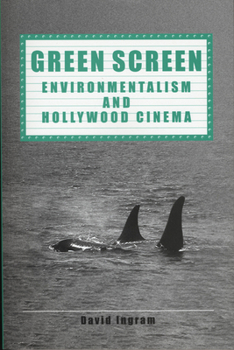Green Screen: Environmentalism and Hollywood Cinema
Select Format
Select Condition 
Book Overview
This book combines film studies with environmental history and politics, aiming to establish a cultural criticism informed by 'green' thought. David Ingram argues that Hollywood cinema has largely perpetuated romantic attitudes to nature and has played an important ideological role in the 'greenwashing' of ecological discourses.
Format:Paperback
Language:English
ISBN:0859896099
ISBN13:9780859896092
Release Date:January 2004
Publisher:University of Exeter Press
Length:240 Pages
Weight:0.40 lbs.
Dimensions:0.7" x 6.0" x 8.7"
Customer Reviews
1 rating
Ground-breaking approach to film studies: ecocriticism applied to Hollywood film
Published by Thriftbooks.com User , 16 years ago
David Ingram's book is a groundbreaking work, that has important implications for film studies, ecocriticism and cultural studies -- and has the merit (unlike many other works in all of these fields) of being both precise and clear. While it holds rewarding insights for those working in these fields, it would be valuable and engaging for anyone interested in Hollywood film and the environment. A few other books have explored environmental issues raised by certain specific films; what David Ingram does is show how attention to a range of issues and distinctions provides an illuminating lens through which to examine a very wide range of mainstream contemporary films. While he examines several very specific issues and subject matters that appear in only some major films, Ingram's analysis of these issues suggests that to some degree most films address them. Wilderness, for example, may not be a central theme of all Hollywood films -- but Ingram's analysis of the cinematography of wilderness reminds us that a central concern of all films is how to represent the place in which the events depicted occur. Just as the depiction of wilderness in mainstream films usually requires a great deal of care in framing out those elements that suggest a human presence, so all depictions of place in films involves careful decisions regarding what to include in the background. Those decisions say something, and play a role in the overall meaning of a film -- a depiction, say, of life in the inner city can be just as false by its exclusions as depiction of wilderness that leaves out telephone poles and roads and the like. The book consists of 12 chapters, each focusing on a theme that has played a central role in several Hollywood films, not only films that are explicitly about the environment but films that establish connections between gender and nature, or distinctions between rural and urban life, films that depict Native Americans or the rainforest or hunting or wildlife, films that raise questions about nuclear power, or demonstrate the culture that surrounds technologies such as the automobile. Each chapter takes a close look at several films, and raises several issues and distinctions to show how these are dealt with in both the plot and imagery of the films. The author's aim in all of this is not so much to convey an environmental message as to demonstrate that environmental messages are implicit in the films we view. His aim is to call attention to these messages, so that they may be critically reflected upon and examined. A very worthwhile project, that is carried out in exemplary fashion in this very readable and engaging volume.





